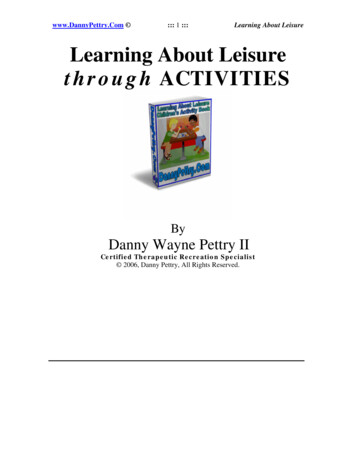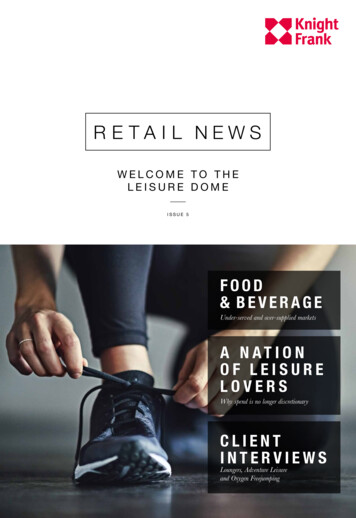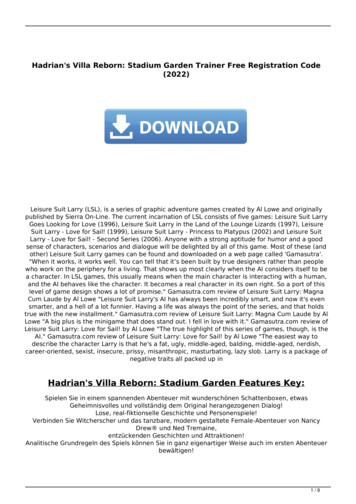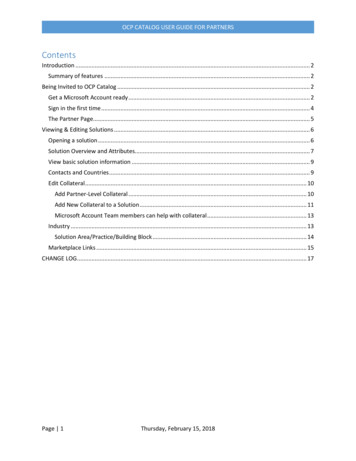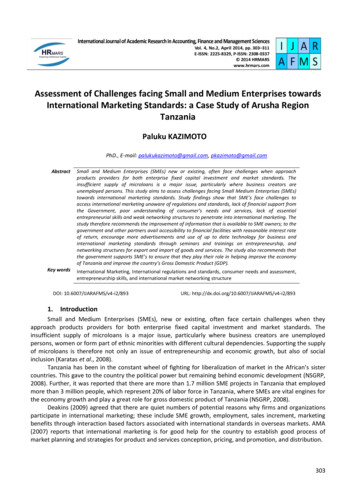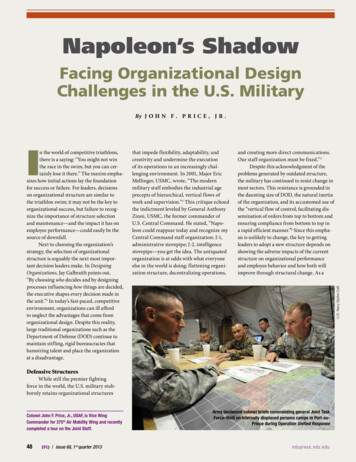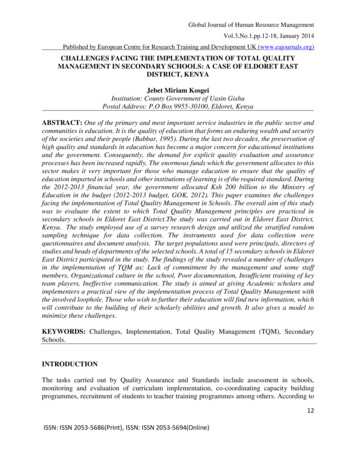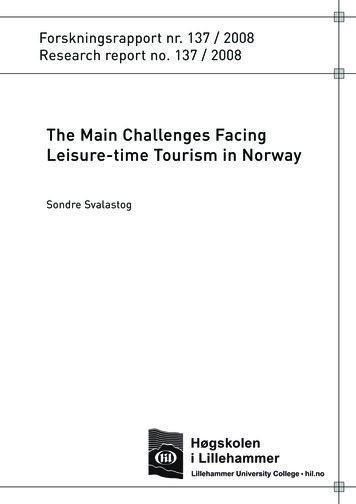
Transcription
Forskningsrapport nr. 137 / 2008Research report no. 137 / 2008The Main Challenges FacingLeisure-time Tourism in NorwaySondre Svalastog
Rapporten er også publisert på internett av Høgskolen i g og publisering/skriftserien ved hilThe report is also published on the web:http://hil.no/hil/biblioteket/forskning og publisering/skriftserien ved hilKr. 50,-ISSN 0807-2647ISBN 82-7184-330-3Alle synspunkter står for forfatterne sin regning. De må ikke tolkes som uttrykk for oppfatninger som kantillegges Høgskolen I Lillehammer. Denne artikkel kan ikke reproduseres - helt eller delvis - ved trykking,fotokopiering eller på annen måte uten tillatelse fra forfatteren.Any views expressed in this article are those of the authors. They should not be interpreted as reflecting theviews of Lillehammer University College. This article may not be reprinted in part or in full without thepermission of the author.
SummaryIn the period after the Second World War, that part of Norwegian tourism industry which isexposed to competition has gone from being an industry with increasing competitiveness1 tobeing an industry with rapidly declining competitiveness. The competitiveness reached itshighest point in 1966. In that year, the export value was 120% of the import value. In 2007,the export value was only 30% of the import value.The most important export markets for Norwegian tourism are the same today as they were atthe end of the 19th century: Great Britain, Germany, USA, Sweden, Denmark, and theNetherlands. In other words, the adjacent markets remain the most important.At first sight, this may seem surprising. The aeroplane has shortened distances and globalizedthe tourist industry. The growth in prosperity in every part of the world has enabled new largegroups of people to travel internationally, and an enormous simplification of the rules aboutvisas, passports and money transfer, beside other time-space shrinking technologies, hasgreatly simplified intercontinental transfers.The principal explanation of the development in the Norwegian tourist industry has threeaspects:1. Competition has increased greatly. New, large-scale and competent suppliers haveemerged in every part of the world. The global supply has increased more quickly thanthe demand. The large-scale producers are active product developers who investheavily in the creation of new demand.2. The growth in prosperity in Norway has been exceptionally high in the last twodecades. The growth in purchasing power means that most Norwegians can make theirchoices on a global basis.3. At the same time, Norwegian tourism industry has been left behind, both in anacademic and in a professional sense.Key words: 1. Operationalization of the concepts, hypothesis, models, and theories ofproduction theory for use in the field of tourism. 2. The importance of knowledge. 3.Documenting the crucial importance that the nature of high quality plays for the leisure timetourism in Norway.About the authorSondre Svalastog is an economist specializing in geography and planning (Bachelor ofAgriculture and Doctor of Economics). He is Professor of Planning in the Faculty of SocialSciences at Lillehammer University College. His research work in recent years hasconcentrated on the themes of resource and production theory, qualitative analyses ofproducts, and sustainable development/sustainable tourism.Office:E-mail:Residence:Phone 47 – 61 28 82 51; Cellphone: 91 52 82 80; Fax: 47 – 61 28 81 70;Sondre.Svalastog@hil.noPhone: 47 – 61 26 30 561 See the list of definitions p. 21.1
ForewordI completed my doctoral dissertation in 1992. Its title was: LOKALISERING AV REISELIV.Om ressursanalyser, den romlige fordeling og lokal innpassing. (if you translate:LOCALIZATION OF TOURISM. The evaluation of resources, spatial distribution, andintegration to local society.) This dissertation led me on to the study of new and veryfascinating problems.As soon as the work on my dissertation was finished, therefore, I began the project: “Mappingresources on regional level and analyzing the possibilities for profitable leisure-related tourism” One of the challenges was to develop my work on the phenomenon of resources, andmore specifically on the resource basis for tourism. The sociological method for theinvestigation and evaluation of resources for tourism and recreation, as I had described this inmy dissertation, was to be further elaborated by means of concrete cases.The second challenge was to develop a method for qualitative analyses of products. It isabsolutely necessary to possess a systematic method which allows us to isolate individualproducts, “hold them up to the light,” and determine what qualitative aspects they have, or canbe made to have.In a high-cost country like Norway, this is vitally important if we are to avoid choosingproductions in a situation of trial and error. A high level of costs always requires nicheproductions that demand knowledge. A low level of costs, on the other hand, generallyindicates mass-produced standard wares (or productions that demand little competence).Exceptions may however occur if a country has a monopoly situations on key resources, andthis is an essential factor in the explanation of the development of Norwegian tourismindustry in the post-War period.The project was organized as a collaborative endeavor between Lillehammer UniversityCollege, the Office of Regional Planning and Regional Development in Buskerud County (atpresent an integrated part of: Department of Regional Development), and the Department forEconomic Development and Transport in Nordland County. Aust-Agder County Council,Office of Regional Development, the Business Section also participated in the final part of theproject period. The Counties identified the areas of field study, and an average of betweeneight and ten analyses on the local-authority level were carried out annually in this period.The project continued until summer 1997, when I moved to Berne University ResearchInstitute for Leisure and Tourism, Switzerland. The academic project had now reached thepoint where I could begin the next stage.The second stage was entitled: “The nature of resources for tourism and recreation.” Thefocus here was on the fact that the most essential aspect of the resource basis is somethingrelative: in other words, that the resource basis can be further developed quantitatively, orqualitatively, or in both directions. In the tourism sector, this perspective opens the door tonumerous interesting challenges in the mid- and longterm, and this can offer interestingimpulses for work on carrying capacity research and sustainable development.This understanding is central to the task of directing changes on individual products and theattraction basis for tourism and recreation in general. This project continued until 2003, andwas followed by work on operationalizing the concepts, models, and theories of productiontheory for use in the field of tourism. This stage began in the spring semester of 2003, when Ihad the full responsibility for the course “The tourism production system” in Tourism Studiesat the Baltic Business School in Kalmar in Sweden. For part of that semester, I commuted2
between Kalmar and Lillehammer University College. Academically speaking, this period asa whole became extremely interesting, but also more demanding than I had thought at theoutset.The present analysis has its basis in the professional understanding of reality to which thethree projects have led me. The analysis is brief, and many of the arguments presuppose thatthe reader is familiar with resource theory, localization theory, and production theory in orderto follow all the shortcuts I take en route. It is also necessary to know the dynamic at work inthose forces that restructure those parts of the industry which are exposed to competition onthe global level. For a vividly written guide to globalizing processes, see Dicken, 2007.What knowledge specific to this sector is presupposed? The reader should be familiar withbasic models of segmentation and with the ongoing globalization of leisure-related tourism.Much information about the globalization of tourism and global restructuring in the touristindustry will be found in Theobald, 2005. One should also be familiar with the broad lines ofdevelopment in Norwegian tourism from the mid-nineteenth century down to the present day.The historical dimension is necessary, if one is to say something well-founded about thequalitative changes that have occurred in Norwegian tourism, and about the place occupiedby this sector in today’s competitive situation.My close colleagues both in Norway and abroad who are researching into parallel or relatedproblems have helped me greatly through continuous contacts, seminars, field trips,comments, tips about important sources and references, etc. You have made the internationalresearch scene more easily accessible and applicable. Openness and closeness have been agreat inspiration and encouragement, and have given me new energy in my daily work. I amdeeply grateful to each one of you, and I shall do my best to intensify our collaboration in theyears that lie ahead.Everything in the report can be checked and in this way exposed to comments and criticisms.The reference material is intended to indicate clearly my own academic standpoint. All pointsof view, comments and questions, whatever form these may take, will be valuable. I thereforeappreciate these gratefully, and I shall respond to them.I am very grateful to Dr. Brian McNeil (Munich) who has translated the text to English,revised the English text, and has made helpful suggestions about the choice of English words,formulations, and expressions.Lillehammer, November 2008Sondre SvalastogSondre.Svalastog@hil.noTel.: 47 61 28 82 51Cellphone: 91 52 82 803
ContentsPART I: THE PRESENT SITUATION.5The Norwegian tourism import and export balance 1950 - 2007.6The competitiveness in leisure time tourism in Norway has never beenweaker than in the last ten to fifteen years.7PART II: MAIN ELEMENTS IN THE ANALYSIS.8Main forms of tourism.8The basis of leisure time tourism is free goods.11From free to processed goods.13Free goods are resources which can be used by people in general,and which do not have a market price.14The manufacturing plants in the tourism business are primarily accommodation.14The main challenges against this background.14The model for the communication and production of knowledge.16The situation as a theoretical model.17PART III: SUMMING UP.20PART IV: THE CONCEPTUAL UNIVERSE WHICH HAS BEEN EMPLOYEDIN THE TEXT.21Capital goods.21Competitiveness.21National level of costs.21Culture.21Leisure experience.22Factors of localization.22Factors of production.23Free goods.23Industrial Leisure.24Marketing.24Producer goods.25Product.25Production.25Public tainable development.30Tourism sector.31Tourist.31Enclosure 1. The specification of tourism expenditure (exports and imports)for the period 1950 - 2007 in nominal value.32Enclosure 2. The resource basis for tourism and recreation - a main survey.33References.344
PART I: THE PRESENT SITUATIONIf you wish to influence on a situation ora challenge, you have to face the reality.I wish to take you on a lightning tour of an understanding of reality which is of decisiveimportance, if we intend our activity to have an effect on the extent and the direction ofthe leisure time tourism which exists here today, and can serve us well in the future.I have appended some models and mainstream definitions to my text. These aresufficient to show how my professional academic understanding of reality is constituted;at the same time, you are given the materials to draw your own independent conclusion.Tourism is production, and is formed by the same laws which govern other economicactivities. In terms of production, tourism is made up of a protected part and a part that isexposed to competition. The protected part includes all work related and locally determineddemand. The production exposed to competition is linked to the leisure-determined demand.Roughly speaking, the protected production is localized in towns, industrial sites, and nodaltraffic points, while the production exposed to competition in our part of the world2 is orientedto the rural areas.In the present study, I have chosen to use the external trade balance in the tourism industry asthe main indicator of how the competitiveness has developed during the post-War period. Theexport and import figures include both journeys linked to work (a part of the protectedproduction) and journeys linked to holidays and leisure (the production exposed tocompetition).Since the 1970’s, the volume of foreigners’ work-linked journeys to Norway has increased,relatively speaking, more than foreigners’ visits related to holidays and leisure. This meansthat the decline in the competitiveness of the holiday- and leisure-linked part of Norwegiantourism is even more dramatic than the sum totals indicate (See: Enclosure 1, p. 32).An overview article like the present study seeks to present the principal patterns andstructures, not to go into details or discuss alternative indicators which could be employed inthe analysis.I have chosen the export and import figures because these are easily understood and areavailable in the form of reports for each individual year, and not least because the sources areauthoritative (Central Bank of Norway and Statistics Norway/SSB). This makes it easy tocompare the course of development with corresponding data from a large number of countriesthroughout the world.The following supplementary, alternative, or independent indicators could have been chosento show the development of competitiveness in the Norwegian tourism industry:1. A survey of where the most important markets are located, and of possible changesover the course of time. In other words, the effects of localization.2 In Norway (and the Nordic countries) and most of the cultural periphery as a whole, leisure time tourism is basicallyoriented to the qualities in the basic natural resources. In Mediterranean regions such as Italy, Greece, Turkey, Israel,Jordan, Egypt, etc., where our culture was born, the opposite is the case. Here, leisure time tourism is largely oriented toculture, and is principally oriented to towns.5
2. Qualitative analyses of products could have been carried out, to see whether thequality has kept pace with the development of wages and prices.3. A third alternative could be to carry out an analysis of changes in the industry’s abilityto create value (value added) and the net returns on capital.All three methods corroborate what the export-imports diagram shows (See Figure 1 below).The Norwegian tourism industry has never had such a low level of competitiveness as in thepresent decade.Figure 1: The Norwegian tourism import and export balance 1950 2007 converted to 1950 kroner**Norwegian tourism income reflects foreign tourists' expenditure while travelling in Norway, (both with work andon holiday), and Norwegian tourism expenditure reflects Norwegians' expenditure while travelling abroad.An adapted version of Svalastog 1992 “Tourism in a changing Norway” The Norwegian Journal of Geographyno. 2.6
1. The competitiveness in leisure time tourism in Norway has neverbeen weaker than in the last ten to fifteen years.This is primarily because Competition on the supply side has become much greater, and the big-scale actors onthe supply side are active product developers who invest heavily in the creation of newdemand. Thanks to the growth in purchasing power, Norwegians can make their choices on aglobal basis. An increasingly imbalance between the development of knowledge and the growth insalaries and costs.The only points which lie within our control are:1. Those connected with the situation of our knowledge.2. The priority given to particular parts of the industry, and3. To specific regions. Porter says in one of his works that “we must abandon the wholenotion of a “competitive nation” as a term having much meaning for economicprosperity” (Porter, M.E. 1990, p. 6).7
PART II: MAIN ELEMENTS IN THE ANALYSIS2. Main forms of tourism.In order to attain an analytic standpoint, we must distinguish between three main categories oftourism:a) Work-related tourism is mainly oriented to densely populated areas, and demand fortourist services occurs where people have tasks to perform. This demand is linked toindividuals who carry out specific commissions, to self-employed persons who makeuse of a variety of services offered to them (e.g. legal, economic and other kinds ofprofessional expertise), to political and diplomatic delegations, and to participants incourses, meetings and conferences linked to the exercise of their own profession andto the tasks involved in their work.b) The leisure sphere provides the other two main forms. I prefer the concept network-based tourism, or the tourism of visits for the firstcategory from the leisure sphere. This is linked to personal networks, i.e. to the factthat people have family, acquaintances and friends with whom they wish to maintaincontacts. In geographical terms, the distribution of network-based tourism correspondsbroadly to the pattern of residence. The other main form within the leisure sphere is here called resource-based tourism.This is that part of tourism which is governed by the possibilities of recreation,activity and specific experiences offered by an area. To some extent, we can equateresources with attractions (Swarbrooke, 2002).8
Figure 2. The main forms of tourism segmented in a localizationperspectiveIf we measure the relative size of these three main forms, we find roughly the samedistribution in Norway and in Sweden: market-based tourism accounts for c. 10%, resourcebased for c. 45%, and network-based for c. 45% measured by overnight stays. In this paper,we concentrate our attention on the resource-based part, which accounts for c. 45% of thetotal volume of travel, measured as above.(For more about the definition: See Notes in Svalastog 1992, p 115).9
Figure 3. Tourism segmented according to localization343 The first six tourist categories in the classification below are from V. Aubert, 1991: 113-140.4 The two last categories in the classification below are from J. Swarbrooke, 2002: 79-80.10
3. The basis of leisure time tourism is free goods.Professor Dr. Yngvar Nielsen wrote in 1886:“Norway has enough mountains, glaciers, waterfalls and fjords to satisfy virtually theentire curious public of Europe and America . . . Norway can never expect to becomefully the equal of Switzerland and Italy, which are located in such a way that they areeasily accessible from many of Europe’s largest and richest lands. This gives themconsiderable advantages over us. We cannot ever aspire to become more than nr. 3 –but even that is something!” (Nielsen, 1886 pp. 54 – 55).The key variables in the analysis by the geographer Yngvar Nielsen are the basis in nature, asthe decisive attraction (free good/resource), and a peripheral location as a limitation (a centrallocalization factor).See: Figure 4. The main factors of localization in details, p. 12.In the introduction to a 240-page Swedish book about Norway as a country for holidays,published in 1957, we read:“Norwegian nature is mountains, fjords, and - - -. Here we have natural scenery whichis as different from Swedish nature as one can imagine, and it is so majestic that it iseasy to understand why many English and American guidebooks give Norway morestars for natural scenery than any other country in Europe. It is not surprising that weSwedes travel so much to Norway – which is so close to us, and yet so different fromus.” (Strømberg, A. editor, 1957).The basic natural resources (free goods) of high quality are still the main reason for choosingNorway as a country for vacation, and the distance between market (Sweden) and place ofproduction (Norway) is small (both in time and in money), and is not spoken of as a directdisadvantage for the English and American market.Fifty years later, in 2005, a large-scale analysis of the German market shows that “Germansdo not travel to Norway because of the food or the culture. Nature is almost the only factorthat draws the tourists northwards” (Anda i Dagens Næringsliv, Friday 13 January 2006).Only 1% indicate “eating well” and another 1% indicate “culture” as the main factor in theirchoice of Norway as a holiday country – in all, 2%.“To experience nature and landscape5 (in general)” is the decisive motivation factor for60%; the fjords 9%; midnight sun/North Cape/Nordkalotten 5%; fishing 5% (mostly fishingfor food in the sea); to experience peace and quietness 4%; sightseeing tourists 4%; walkingtours 3%; other possibilities for outdoor activities 3%. In all, 93%.The network-based share amounts in all to 3% (family reasons 2%; visiting parents wholive there 1%).It is difficult to fit the others into specific categories. (A. Enger/ANIARA - markedsanalysefor reiselivet, 2005).5 The tourist himself to a large extent includes cultural landscape in the concept of nature. So we face a discrepancy in thesources referred to above. On the other hand, it is pretty common to say: “Nature also includes culture in those caseswhere cultural activities are directly based on natural conditions --” (Aronsson, p. 43). As scholars we have to be aware ofthese two different ways of using the concept, otherwise we misinterpret!11
Figure 4. The main factors of localization in detailsAdapted from Svalastog: “Reiselivsnæringens ressursgrunnlag” in Jacobsen and Viken (eds.) “TURISME.Fenomen og næring”, p. 179. Oslo 2002: Gyldendal Akademiske.12
The basic natural presuppositions are still equally dominant, and although the material doesnot explicitly state this, there are good reasons to assume that distance as a localization factorhas become an advantage rather than as a disadvantage. Norway is easily accessible, but it isalso exotic in the German market.Accordingly, free goods have been, and will continue to be, the main base of Norwegianleisure time tourism. See Figure 5:Figure 5. From free to processed goods1.2.3.4. Sightseeing tours to the Hardanger Fjord region during the fruit-blossoming season All kinds of fishing in salt water All kinds of hiking tours, outdoor life inclusive of all kinds of water sports in salt and (most frequently)fresh water Visiting tourist attractions like the World Heritage Town of Røros on one’s own (without commercialguiding) Ordinary sightseeing tours by car, bus, etc. Hunting areas that are open to the tourist market Fishing rights that are open to the tourist market6 Most forms of artificially made attractions like indoor bathing complex, amusement parks, put-and-takefishing, etc. The predominant part of farm tourism The predominant part of what the tourist on vacation is offered at Norwegian destinations bothsummer and winter, etc. Some Norwegian winter-products such as alpine- and cross-country slopes and landscapesThe gastronomic cluster in Lom municipality around Arne Brimi, Fossheim Tourist Hotel, etc.Guided rafting and wildlife in chosen areas (see as an example: www.nwr.no)Know-how-based farm tourism (see as an example: www.fiskebekk.no)Safaris such as Andøy Whale Safari (www.whalesafari.com), etc.6 As the concept is coined by E.W. Zimmerman in Peach and Constantin.13
4. Free goods are resources which can be used by people ingeneral, and which do not have a market price.Free goods must not be confused with products. Products are output from a “transformationprocess which are directed by human beings, or which human beings are interested in, namelya transformation which a certain group7 of people consider desirable. The term indicates thatthere are certain things (goods or services) which enter into the process, and lose their identityin it, i.e. cease to exist in their original form, while other things (goods or services) come intobeing in that they emerge from the process”8 (Frisch, R., 1965 p 3) For a main survey of theresource basis for tourism and recreation, see enclosure 2, p. 33.5. The manufacturing plants in the tourism business are primarilyaccommodation (lodging- and dining places).The scientific concept for this is superstructure. The superstructure is sold to the tourist in theform of products, but it is highly exceptional for the superstructure itself to be an attractionthat determines the tourist’s choice of travel. In terms of the theory of production, the touristis the producer, because generally it is the tourist himself who puts together the contents of hisholiday or weekend trip. The various industries in this sector are principally suppliers of rawmaterial and partial components. The superstructure should not be confused with the conceptof infrastructure9.6. The main challenges against this backgroundIf it is true to affirm that the basis of our leisure time tourism lies in free goods, then adecisive longterm role is played by the competence we commit to caring for and developingthose parts of the basic resources (both natural and cultural) which constitute these freegoods.7 In the formulation “which a certain group of people consider desirable” lies the justification for segmenting the touristmarket into demand groups, or categories of tourists. A sociological approach is necessary when we analyze what is“desirable” and to what extent a good is capable of satisfying needs. These are the simple rea
tillegges Høgskolen I Lillehammer. Denne artikkel kan ikke reproduseres - helt eller delvis - ved trykking, fotokopiering eller på annen måte uten tillatelse fra forfatteren. Any views expressed in this article are those of the authors. They should not be interpreted as reflecting the views of Lillehammer University College.


